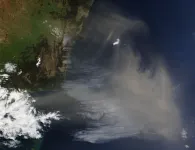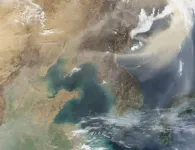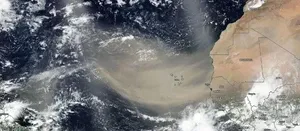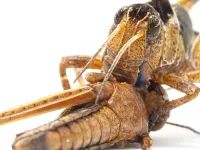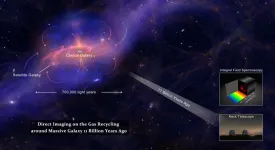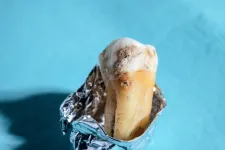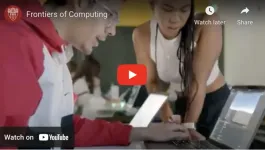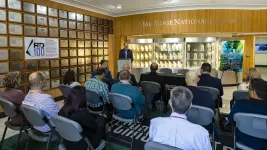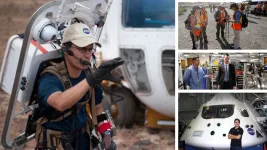(Press-News.org) CORVALLIS, Ore. – New research led by an Oregon State University scientist begins to unravel the role dust plays in nourishing global ocean ecosystems while helping regulate atmospheric carbon dioxide levels.
Researchers have long known that phytoplankton – plantlike organisms that live in the upper part of the ocean and are the foundation of the marine food web – rely on dust from land-based sources for key nutrients. But the extent and magnitude of the impact of the dust – particles from sources such as soil that are lifted by the wind and impact the Earth’s climate – have been difficult to estimate globally.
“This is really the first time it has been shown, using the modern observational record and at the global scale, that the nutrients carried by dust being deposited on the ocean are creating a response in the surface ocean biology,” said Toby Westberry, an oceanographer at Oregon State and lead author of the just-published paper in Science.
The ocean plays an important role in the carbon cycle; carbon dioxide from the atmosphere dissolves in surface waters, where phytoplankton turn the carbon into organic matter through photosynthesis. Some of the newly formed organic matter sinks from the surface ocean to the deep sea, where it is locked away, a pathway known as the biological pump.
In the new paper, Westberry and other scientists from Oregon State; University of Maryland, Baltimore County; and NASA Goddard Space Flight Center estimate deposition of dust supports 4.5% of the global annual export production, or sink, of carbon. Regional variation in this contribution can be much higher, approaching 20% to 40%, they found.
“That’s important because it’s a pathway to get carbon out of the atmosphere and down into the deep ocean,” Westberry said. “The biological pump is one of the key controls on atmospheric carbon dioxide, which is a dominant factor driving global warming and climate change.”
In the ocean, vital nutrients for phytoplankton growth are largely provided through the physical movement of those nutrients from deep waters up to the surface, a process known as mixing or upwelling. But some nutrients are also provided through atmospheric dust.
To date, the understanding of the response by natural marine ecosystems to atmospheric inputs has been limited to singularly large events, such as wildfires, volcanic eruptions and extreme dust storms. In fact, previous research by Westberry and others examined ecosystem responses following the 2008 eruption on Kasatochi Island in southwestern Alaska.
In the new paper, Westberry and Michael Behrenfeld, an Oregon State professor in the Department of Botany and Plant Pathology, along with scientists from UMBC and NASA built on this past research to look at phytoplankton response worldwide.
Westberry and Behrenfeld focused their efforts on using satellite data to examine changes in ocean color following dust inputs. Ocean color imagery is collected across the global ocean every day and reports changes in the abundance of phytoplankton and their overall health. For example, greener water generally corresponds to abundant and healthy phytoplankton populations, while bluer waters represent regions where phytoplankton are scarce and often undernourished.
The scientists at UMBC and NASA focused their efforts on modeling dust transport and deposition to the ocean surface.
“Determining how much dust is deposited into the ocean is hard, because much of the deposition occurs during rainstorms when satellites cannot see the dust. That is why we turned to a model,” said UMBC’s Lorraine Remer, research professor at the Goddard Earth Sciences Technology and Research Center II, a consortium led by UMBC. The UMBC team used observations to confirm a NASA global model before incorporating its results into the study.
Working together, the research team found that the response of phytoplankton to dust deposition varies based on location.
In low-latitude ocean regions, the signature of dust input is predominately seen as an improvement in phytoplankton health, but not abundance. In contrast, phytoplankton in higher-latitude waters often show improved health and increased abundance when dust is provided. This contrast reflects differing relationships between phytoplankton and the animals that eat them.
Lower latitude environments tend to be more stable, leading to a tight balance between phytoplankton growth and predation. Thus, when dust improves phytoplankton health, or growth rate, this new production is rapidly consumed and almost immediately transferred up the food chain.
At higher latitudes, the link between phytoplankton and their predators is weaker because of constantly changing environmental conditions. Accordingly, when dust stimulates phytoplankton growth, the predators are a step behind, and the phytoplankton populations exhibit both improved health and increased abundance.
The research team is continuing this research, bringing in improved modeling tools and preparing for more advanced satellite data from NASA’s upcoming Plankton, Aerosol, Cloud, ocean Ecosystem (PACE) satellite mission, some of which will be collected by the UMBC-designed and -built HARP2 instrument.
“The current analysis demonstrates measurable ocean biological responses to an enormous dynamic range in atmospheric inputs,” Westberry said. “We anticipate that, as the planet continues to warm, this link between the atmosphere and oceans will change.”
END
Scientists begin to unravel global role of atmospheric dust in nourishing oceans
2023-05-04
ELSE PRESS RELEASES FROM THIS DATE:
Chemical signal protects migratory locusts from cannibalism
2023-05-04
Huge swarms of migratory locusts take on the proportions of natural disasters and threaten the food supply of millions of people, especially in Africa and Asia. As the eighth of the ten biblical plagues, the Book of Moses in the Old Testament already describes how swarms of locusts darkened the sky and ate up everything that grew in the fields and on the trees. Scientists suspect that cannibalism among locusts contributes to their swarming behavior, and swarms therefore constantly move ...
Pheromone deters swarming migratory locusts from cannibalism
2023-05-04
Swarming migratory locusts – which threaten food security across the globe – avoid being eaten by other locusts by producing a smelly pheromone called phenylacetonitrile (PAN), according to a new study. The discovery of an anticannibalistic signaling pathway in locusts could provide a target for locust management strategies since cannibalistic interactions among locusts have been implicated in creation of swarms, which are highly destructive. A wide range of species practice cannibalism, mostly to supplement nutrition. This has led to the evolution of ...
Social-belonging intervention promotes college success, increasing proportion of students who complete first year
2023-05-04
A randomized controlled experiment featuring more than 26,000 students across 22 4-year U.S. universities shows that the effects of a low-cost, brief online intervention focused on social belonging can promote success and equity for college students. This finding was particularly apparent among those from groups that have historically achieved at lower rates. The likelihood of earning a university degree in the U.S. is highly unequal across racial-ethnic and socioeconomic groups. In most cases, programs designed to help, by promoting college persistence, work differently for different people. Understanding these heterogenous effects ...
Recycled gas feeds a massive galaxy in the early Universe
2023-05-04
Streams of intergalactic gas, enriched with elements heavier than helium, encircle and spiral into a massive galaxy observed at redshift 2.3, researchers report. The findings provide evidence of enriched gas recycling during galaxy formation in the early Universe. Galaxies form through the accretion of gas from the circumgalactic medium (CGM) and intergalactic medium (IGM), which subsequently condenses into stars. Simulations and observations have shown that cold stream accretion – the accumulation of pristine intergalactic gas that contains almost no elements heavier ...
Reconstructing Pleistocene bacterial metabolites to revive their natural products
2023-05-04
Reconstructing the bacterial genomes recovered from the calcified plaque of human and Neanderthal remains has offered new insights into previously undescribed Pleistocene bacterial metabolites, researchers report. The approach expands researchers ability to study microbial natural products, which has otherwise been mostly limited to studying living bacteria. Bioactive small molecules produced by microbes, often called natural products, have been an important source of diverse functional compounds for industry and medicine, including many antimicrobials. Characterizing the natural products encoded in biosynthetic gene clusters ...
CRISPR and single-cell sequencing pinpoint causal genetic variants for traits and diseases
2023-05-04
A major challenge in human genetics is understanding which parts of the genome drive specific traits or contribute to disease risk. This challenge is even greater for genetic variants found in the 98% of the genome that does not encode proteins.
A new approach developed by researchers at New York University and the New York Genome Center combines genetic association studies, gene editing, and single-cell sequencing to address these challenges and discover causal variants and genetic mechanisms for ...
University of Southern California launches $1B-plus initiative for computing including AI, advanced computation and quantum computing
2023-05-04
USC President Carol L. Folt on Thursday announced a $1 billion-plus initiative for computing research and education across disciplines, with a focus on AI, machine learning and data science, augmented and virtual reality, robotics, gaming and block chain.
“I want every student who comes through our programs, whether they are in science, business, the humanities or the arts, to have a solid grounding in technology and the ethics of the work that they do,” Folt said. “We will integrate digital literacy across disciplines to create responsible leaders for the workforce of the future.”
Seeded with a $260 million gift from the ...
Teletrix licenses methods for ionizing radiation training using augmented reality
2023-05-04
A method using augmented reality to create accurate visual representations of ionizing radiation, developed at the Department of Energy’s Oak Ridge National Laboratory, has been licensed by Teletrix, a firm that creates advanced simulation tools to train the nation’s radiation control workforce.
Ionizing radiation — which is linked to cancer and other health problems — has enough energy to knock electrons off of atoms or molecules, creating ions. Occupational exposure is a common occurrence for many radiological workers, so any method of decreasing exposure helps ...
$1.4M research pipeline grant funds increased diversity of biomedical sciences workforce
2023-05-04
The National Institutes of Health has renewed a 5-year biomedical sciences research pipeline grant to LSU Health New Orleans. With the $1.4 million Postbaccalaureate Research Education Program (PREP) grant awarded by the National Institute of General Medical Sciences, LSU Health New Orleans will enhance the diversity of the biomedical sciences research workforce.
During a comprehensive one-year research education program, LSU Health New Orleans faculty will prepare individuals from backgrounds underrepresented in the biomedical sciences ...
UTEP awarded numerous grants to support NASA space research
2023-05-04
EL PASO, Texas (May 4, 2023) – Researchers at The University of Texas at El Paso will help build a robotic device for welding in space, prepare astronauts for a mission to the Moon and more, thanks to a slew of new grants from NASA.
The burst of grants awarded to faculty across various departments and colleges highlight UTEP’s strong partnership with NASA and the critical scientific and engineering contributions made by the University for space exploration.
“These joint initiatives between UTEP and NASA strengthen UTEP’s reputation as a premier research institution,” said Stephen Aley, Ph.D., ...
